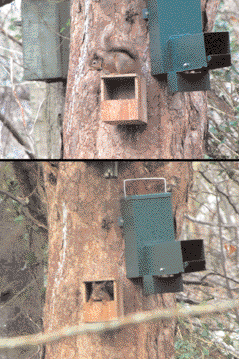|
Wildlife
Newsletter for the Township of Dalkey February 2013 - Michael Ryan |
| The
very mild weather at the turn of the year brought the usual unseasonable
records. I usually see the first year's leaves on a Horse Chestnut in
early March but in the second week in January there were new leaves
on Sycamores trees on Killiney hill and new leaves on Alder trees in
Booterstown. A male Dunnock was singing from the top of a gorse bush
on Dalkey in mid January months before he’d normally be expected
to and any mild mornings were full of the lovely song of Song Thrushes
sounding through the darkness. Love seemed to be in the air for foxes,
hearing a male barking below the Vico Road and a little later hearing
the same sound in my own garden where later a pair of foxes were observed
nonchalantly trotting across the lawn together. Evidently his barking
had done the job and won him the heart of a female. |
|
|
But
in December when I heard there had been regular recent sightings of
a flock of waxwings that was a different matter. Waxwings are spectacular,
easily identifiable and there was a flock of them. But the best thing
about the sighting was they’d been seen at various locations along
Avondale Road in Killiney. Next day I drove the length of Avondale Road
on my way home at lunchtime. It was a cold but very sunny day, visibility
perfect. I got to the Barnhill Road end but no sigh of any unusual birds.
I thought I’d try another look so back around the roundabout and
up Avondale Road again. A small tree stood beside the footpath at the
crest of the incline, its bare branches backlit by the low midday sun
and on top of it was a flock of birds which, although only visible in
silhouette, were unmistakably the waxwings. With their tall plume like
crest, black eye mask, yellow tips to feathers and tail they look very
exotic. You could imagine them in tropical forests but they are northern
European birds breeding in coniferous forests near the Arctic circle.
A poor berry crop at home sometimes drives them south in what is known
as a ‘irruption’ and this winter brought them to the UK
and Ireland in record numbers. |
|
 Squirrels inside and outside feeders |
Returning
after lunch they were at the other end of the road strung along a telegraph
line till a very perturbed Mistle Thrush, although greatly outnumbered,
defended his berry patch by launching a attack on them which sent them
packing. Waxwings get their name from the red wingtips which, when their
wing is folded, resembles a blob of the red wax which used to be dripped
hot on to envelopes of important documents to seal them. Their Latin
generic name is Bombycilla garrulus, which derives from Bombyx meaning
silk and cilla meaning ‘tail’ which refers to their silky-soft
plumage while garrulous meaning talkative refers to their constant chattering.
A charming name for a charming little bird. In November we eventually got to see the Great Spotted Woodpecker that had been reported on Killiney Hill and the Friday before Christmas we got to see three separate pairs of the released red squirrels, at one stage causing a minor human traffic jam on the path above the Vico as my companion Lucy showed people the red she had spotted perched on the very top of a Larch tree. As far as I know the woodpecker hasn’t been seen recently on Killiney Hill but became a regular visitor to a feeder in a garden at the back of Mullins Hill. For a while the squirrels were very obliging, coming down to feeders and being seen reasonably easily. On one occasion I quietly approached one of the feeding stations and was rewarded with a charming sight. A squirrel had gone into a open fronted box and was looking out, at one stage with its tiny paws resting on the opening as if it was a little shopkeeper. If it had been wearing a bonnet and a pinafore it would have passed as a character out of a Beatrix Potter story. |
By the time of publication the researchers will have trapped the squirrels and removed their radio collars before re releasing them, hoping some of them might pair up and start a family. It was good to see our original remaining red was still around, distinguished by her lack of a collar. It’ll be much more difficult to recognise her when the others lose their collars although the imported Wexford reds have a much browner tinge while our survivor has a much more consistently red tinge to her fur. When the squirrels are re-released the researchers will become much more reliant on sightings by the public. Lots of up to date information on the Killiney Hill Red Squirrel Group page on Facebook. |